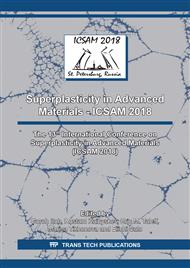[1]
Alemdağ, Y., Beder, M., Microstructural, mechanical and tribological properties of Al–7Si– (0–5) Zn alloys, Materials & Design, 2014, 63: 159-167.
DOI: 10.1016/j.matdes.2014.06.006
Google Scholar
[2]
Kori SA, Murty BS, Chakraborty M. Development of an efficient grain refiner for Al–7Si alloy and its modification with strontium. Mater Sci Eng A 2000;283:94–104.
DOI: 10.1016/s0921-5093(99)00794-7
Google Scholar
[3]
Gupta M, Ling S. Microstructure and mechanical properties of hypo/hypereutectic Al–Si alloys synthesized using a near-net shape forming technique. J Alloys Comp 1999; 287: 284–94.
DOI: 10.1016/s0925-8388(99)00062-6
Google Scholar
[4]
Birol Y. Semisolid processing of near-eutectic and hypereutectic Al–Si–Cu alloys. J Mater Sci 2008; 43:3577–81.
DOI: 10.1007/s10853-008-2565-6
Google Scholar
[5]
Valiev, R. Z., & Langdon, T. G. (2006). Principles of equal-channel angular pressing as a processing tool for grain refinement. Progress in materials science, 51(7), 881-981.
DOI: 10.1016/j.pmatsci.2006.02.003
Google Scholar
[6]
Zhilyaev, A. P., & Langdon, T. G. (2008). Using high-pressure torsion for metal processing: Fundamentals and applications. Progress in Materials Science, 53(6), 893-979.
DOI: 10.1016/j.pmatsci.2008.03.002
Google Scholar
[7]
Saito, Y., Tsuji, N., Utsunomiya, H., Sakai, T., & Hong, R. G. (1998). Ultra-fine grained bulk aluminum produced by accumulative roll-bonding (ARB) process. Scripta materialia, 39(9), 1221-1227.
DOI: 10.1016/s1359-6462(98)00302-9
Google Scholar
[8]
Huang, X., Tsuji, N., Hansen, N., & Minamino, Y. (2003). Microstructural evolution during accumulative roll-bonding of commercial purity aluminium. Materials Science and Engineering: A, 340(1-2), 265-271.
DOI: 10.1016/s0921-5093(02)00182-x
Google Scholar
[9]
ZHU, Qing Feng, et al. Effect of Forging Temperature on Deformability and Structure Evolution of High Purity Aluminium during Multi-Directional Forging Process. In: Materials Science Forum. Trans Tech Publications, 2017. pp.371-379.
DOI: 10.4028/www.scientific.net/msf.877.371
Google Scholar
[10]
Purcek, G., Saray, O., & Kul, O. (2010). Microstructural evolution and mechanical properties of severely deformed Al-12Si casting alloy by equal-channel angular extrusion. Metals and Materials International, 16(1), 145-154.
DOI: 10.1007/s12540-010-0145-1
Google Scholar
[11]
Rao PN, Singh D, Jayaganthan R. Effect of annealing on microstructure and mechanical properties of Al 6061 alloy processed by cryorolling. Mater Sci Technol 2013;29:76–82.
DOI: 10.1179/1743284712y.0000000041
Google Scholar
[12]
Singh JB, Kapoor R, Durga Prasad A, Chakravartty JK. Comparison of microstructures and strengths of an Al–25Mg alloy subjected to severe plastic deformation at room and liquid nitrogen temperatures. Mater Sci Eng A 2013;581:26–30.
DOI: 10.1016/j.msea.2013.05.073
Google Scholar


